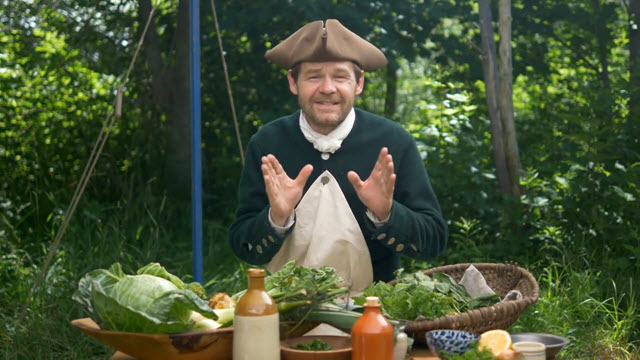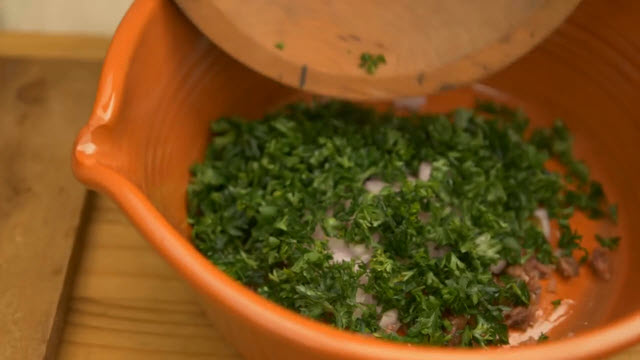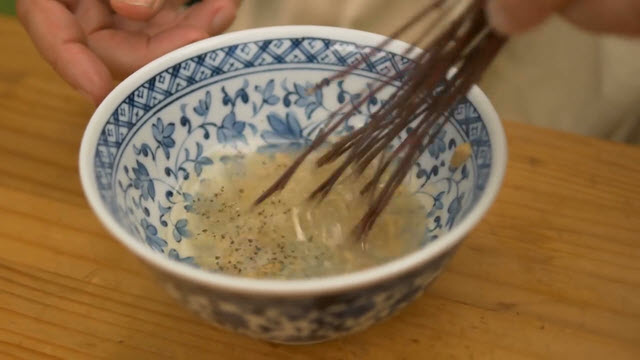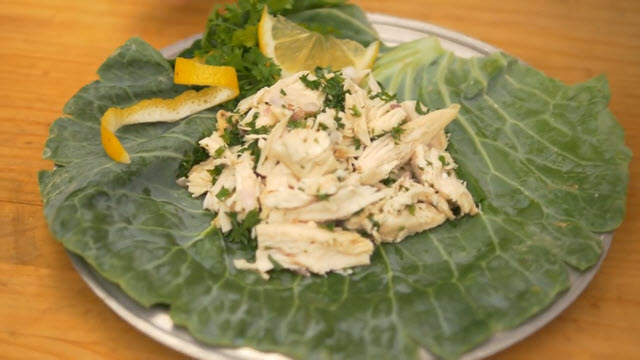
This recipe is called a French Salad and it comes from Maria Rundell’s 1808 cookbook, “A New System of Domestic Cookery”, but even though it is a 19th century recipe, it is very similar to a number of different 18th century recipes for salads.
- 2 or 3 Anchovies
- 1 Chopped Shallot
- ¾ cup chopped Parsley
- 1 Tbsp. Olive or Almond Oil
- 2 Tbsp. Lemon Juice
- 2 Tbsp. Distilled Vinegar
- 1 tsp. Mustard of choice
- Salt to taste
- Pepper to taste
- ¾ pound Roasted Chicken completely cooled
 Mince your anchovies and mix with the shallot and parsley. In another bowl, mix your oil with the lemon juice, vinegar, mustard, salt and pepper and whisk together, then add it back to the other bowl and mix well.
Mince your anchovies and mix with the shallot and parsley. In another bowl, mix your oil with the lemon juice, vinegar, mustard, salt and pepper and whisk together, then add it back to the other bowl and mix well.  Next, break your chicken up into small pieces or strips and add it to the vinaigrette, completely coating the chicken. Cover your bowl and set aside in a cool place like your refrigerator for about 3 hours.
Next, break your chicken up into small pieces or strips and add it to the vinaigrette, completely coating the chicken. Cover your bowl and set aside in a cool place like your refrigerator for about 3 hours.

This would traditionally have been served on toast, but can also be served as a sandwich or even straight out of the bowl.
Transcription of Video:
Today I’m going to be demonstrating a simple and refreshing chicken salad right out of the 18th century. Thanks for joining us today on 18th Century Cooking.
Today’s recipe is called a French Salad and it comes from Maria Rundell’s 1808 cookbook, “A New System of Domestic Cookery”. I know, 1808, now that’s the early 19th century isn’t it, but it turns out that this is very similar to a number of different 18th century recipes for salad. Salads have been around for hundreds of years, even thousands of years. We know that the Romans had salads and especially in the 17th and 18th century, the French and Italians were known for their salads.
Now the salads, this one’s called a French salad, and that’s quite likely because the English were so fond of French cooking and in fact they imported French cooks to cook for them and so salads were kind of known as a French dish in the English culture.
In the 18th century, salads took on many different forms. Of course, they had their cabbages and their lettuces. In fact, today we know this as Romain lettuce, in the 18th century it was just Roman lettuce. They also had a variety of vegetables. Endive, radish tops, leeks, and green onions were commonly used. Some vegetable salads were raw and some were cooked or even boiled. Other salads used meats or pickled fish. They also used herbs in their salads, not just as accents, but as major ingredients. Things where we might never put into a salad.
Now many people think of flowers in a salad as a new thing, but in fact in the 18th century, flowers were very common in salads. They had periwinkle and violets, nasturtium, those were all in 18th century salad recipes. Sometimes they were fresh and other times they might be candied. They were favored for, not only their color, but their flavor also. Ivy did a video a year ago on how to candy violets. If you haven’t seen that video, I invite you to watch it. I’ll make sure to put a link down in the description of this video.
Now what we’re making today is a meat salad. Now the common element that seems to tie all these kinds of salads together was the dressing which was usually some kind of vinaigrette and that’s where we’re going to start.
I’m going to mince 2 or 3 anchovies and put those in a large bowl, mix them with 1 chopped shallot and about ¾ of a cup of chopped parsley. The recipe calls for oil, about a tablespoon of oil and I’m using olive oil here. Now occasionally they would have used, say an almond oil also in an 18th century recipe like this and that might be an interesting variation you could try.
So now let’s add the acid. We need about twice as much acid. The recipe calls just for vinegar. Now likely what they mean is a malt vinegar in the time period. I’m not using malt vinegar today, but actually half lemon juice, about 2 tablespoons, and half distilled vinegar. To this I’ll add a teaspoon of, say the mustard of my choice, along with a little bit of salt, a little bit of pepper and I’m going to whisk this together.
Now it’s time for the meat. I have here some roasted chicken. It’s about ¾ of a pound that I had from earlier. It’s completely cooled and I can start to add this to our vinaigrette. This needs to be covered and set aside for about 3 hours so that the flavors can blend. I suggest you store it in a cool place like your refrigerator.
So, let’s give this a try.
Mmm, wonderful blend of flavors. They’re all right there. You can get a little bit of that lemon juice, but it’s not overpowering and it works so well with that oil. It all blends together so well and those flavors are just boom, they’re just right there. So this one is really good and they likely would have served this over toast or, you know, in a modern context this would go really good on a croissant although they didn’t have anything quite like that in the 18th century, but still, and you could just eat it just like this, just right out of a bowl. It is great.
Well, there you have it, a delightful 18th century chicken salad. Really good, very simple. You should try this one out. You know, I really want to encourage you to share this video. If you enjoyed it please share it on Facebook or the social network of your choice. Whenever you do that, it is so helpful, so thank you for that and if you’re interested in living history, in reenacting, we’ve got this great little getting started course. It’s a free 7 or 8 episode course and it’s kind of fun. You’ll learn a lot, so definitely check that out. I’ll put a link down in the description section of this video and I want to thank you for coming along as we try out these really interesting recipes from history, as we savor the flavors and the aromas of the 18th century.
If you’re new to our channel, I want to welcome you. You can subscribe by clicking the button right up here. Also, check out our related videos. Thanks so much for watching.


Have you tried it true to the original ingredients that would have been used and done a side by side taste test?
Hi Lori. I apologize for the delay in my response. This is a good question, especially considering how certain ingredients, e.g., wheat flour, leavening agents, the size of eggs, etc. have changed through the years due to process changes, hybridization, and so on. In any case, the best we can do is an approximation of the original dish. We can use heritage breeds when they are available, and ingredients that were processed in historic fashion. Even then, however, most modern people have a different palate than those living in the 18th century due to the massive amounts of sugar consumed in comparison to back then. This factor alone combined with the lack of preciseness in 18th century recipes truly makes exact replication impossible. Pertaining to Salmongundy, I’m not sure how we could get closer to the original ingredients, other than by possibly using a heritage breed chicken. Few people have access to that, which is why I opted for conventional chicken instead. So that’s a long answer to your question, but that explains why I have not done a side-by-side comparison.
Your chicken salad sounds lovely! In fact, it’s got me craving a chicken salad sandwich and I’ve not even had breakfast yet!